The Vamps Part 5: Asta Nielsen, Gender, and The Flappers

An aspect of Vampdom that I pointed out in past posts is a non-conformity to contemporary social norms established for women. In many Vamp roles, this manifests as women with definitive agency in their sex lives who indulge in other activities “unseemly” for women like carousing, drinking, and smoking. All together, this results in a sometimes monstrous, sometimes empowering vision of liberated femininity.
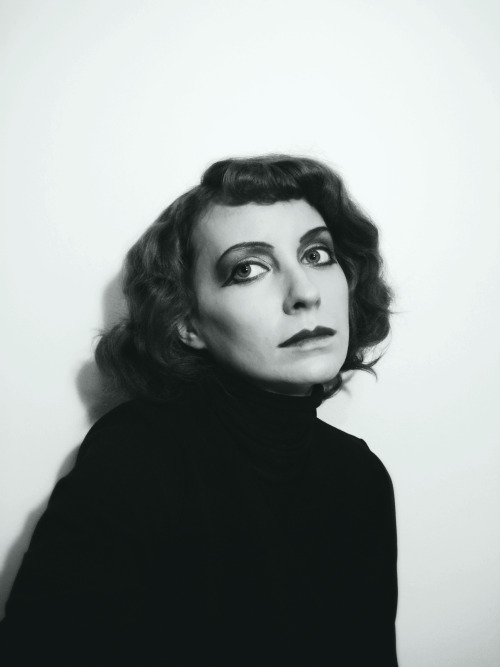
As the teens progressed, (some) women were starting to achieve the rights and freedoms they were agitating for. The First World War broke out–resulting in massive societal shifts, particularly in Europe. By the end of that war, the Vamp had lost her bite. The Flapper, who was first conceptualized around the same time as the Vamp, started to blossom as an archetype. The Flapper phenomenon had already taken hold by the time the eponymous film, The Flapper (1920), came out.
With this paradigm shift, the idea of non-conformity to gender roles and expression was transmuted from Vamps to Flappers. This new image of liberation was more youthful and a lot less Spiritualist. It’s honestly odd to look back at Louise Brooks from 2018 and think of her as unfeminine, but compared to the earlier styling norms, there’s a marked difference in gender presentation. Hair got much shorter, or women would style their longer hair in mock bobs. (Remember a few years ago when people were braiding the hair on the sides of their heads to fake an undercut? Yeah, like that.) Hemlines got ever so slightly higher (still below the knee). The idealized body type moved from full hourglasses to a boyish, unrestrained figure. However, while Vampdom was largely the domain of fictional characters, Flappers were real-life women too.
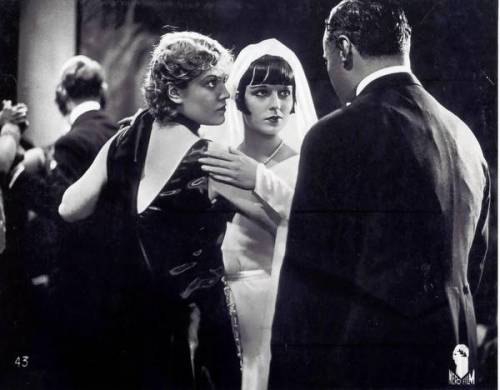
Flappers on film still had much in common with Vamps despite the strong style shift. In a way, the Flapper feels like the Vamp’s little sister. Flappers were emboldened young women, wanton with expressions of their sexuality, sometimes to the detriment of themselves or of weak-willed men. The results of their antics could be tragic or reformative. Flappers are often more sympathetic characters than Vamps.
The actresses that had fully shaped their careers around Vamp roles started to go stale in the public imagination right as Flappers came into vogue. Theda Bara’s star started to flicker and she retired in the 1920s. Pola Negri had a more diverse career, but even she struggled to keep her popularity and relevance in the American film industry in the 1920s.
These developments are precisely why I chose to close out this series with Asta Nielsen. Asta had a singular career. Though it only lasted two decades, the creative control she executed over her films and star image gave Asta the freedom to play all manner of roles. She cut her teeth with Vampy roles but expanded on their non-conformity to gender roles. She crossdressed often, though her crossdressing was never just for yucks. Asta brought modernity to her roles. She’s not an easy figure to categorize as a single type, but boy did Asta make a compelling Vamp.
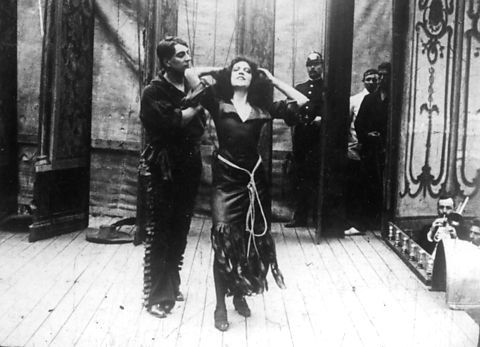
Asta Nielsen was born to a poor family in Copenhagen in the 1880s. As a teenager, she tried to break into the Danish theater scene with limited success. Nevertheless, Asta made the right connections to land a leading role in Afgrunden/The Abyss (1910). Her role of Magda Vang (what a name!) would quickly establish her as an international star and the film was a hit. The Abyss is what was termed an “erotic melodrama.” It follows a music teacher (Asta) engaged to a reverend’s son (Robert Dinesen). She drops their engagement to run away with a lothario circus performer (Poul Reumert). Things are pretty messy from there on out. Even by modern US standards, Asta’s performance opposite Reumert is racy and overtly sexual. Unsurprisingly perhaps, the film was edited for its American release because US censors weren’t too keen on a woman in a skin-tight costume tying up her lover and gyrating all around him. For real.
Even this early on, Asta’s acting is startlingly naturalistic. (That said, I don’t much like how often people suggest that she was the only actor not going into histrionics?) There’s an energy in all of Asta’s performances, even The Abyss at only 21 years old, that seems like she silently saying “Gender? I hardly know her.” I know that’s a weird and hazy statement to make, but you really need to see some of her films for yourself to see what I’m getting at. Words fail when you try to describe Asta.
Asta’s popularity after The Abyss was so great that she was quickly imported to a larger film industry in Germany. By 1911, a new film production division, Internationale Film-Vertriebs-Gesellschaft, was built around Asta in Vienna with Paul Davidson of Projektions-Aktiengesellschaft Union (PAGU) and Urban Gad, Asta’s director/husband. The goal behind this production arm was to make the best vehicles for Asta. Asta was even given creative say so over all the productions. In her memoirs, Asta claims she was involved in most every aspect of the filmmaking process. Not only did she have control over her image, she also had systemic support and assured international distribution for all of her films. Some other women filmmaker contemporaries struggled to turn a profit on their films largely because of a lack of industrial support (like Musidora). The massive success of Asta, and of Mary Pickford and Frances Marion in the US, shows what a difference having the machine behind you makes.

In Germany/Austria, Asta made a wide array of films: dramas imbued with Asta’s trademark “spiritualized eroticism,” broad comedies, and social justice films. Asta did a turn as a fictionalized version of Emmeline Pankhurst in The Suffragette (1913), enshrining the work of Pankhurst and her compatriots. In Das Liebes ABC / The ABCs of Love (1916), Asta crossdresses to teach her fiance how to be a man because she’s better at it than he is. (It’s even queerer than it sounds.)
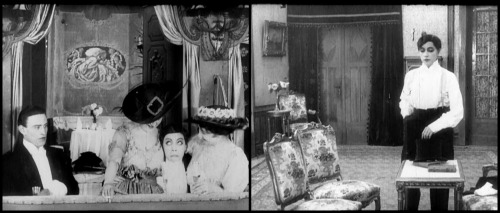
After World War I, Asta undertook a unique project that has lingered in the public consciousness: Hamlet (1921). It’s also the film I chose to cosplay. Based on a somewhat offbeat interpretation of Shakespeare’s play, Asta’s Hamlet is a woman, raised as a man as royal succession insurance. Though the original interpretation has problematic elements to it, the film is subversive and enthralling. Asta has been touted as a master of the silent soliloquy and so the casting is impeccable. She’s astounding in the role and her scenes with Horatio are… something else. Asta’s Hamlet isn’t just a cool look or a great tumblr gif set, it’s emblematic of her approach to film performance. Asta’s performances are always layered–her characters contain multitudes. She truly had a knack for polymorphically expressing emotions and identities all at once and all together. Hamlet makes that tendency in her performances literal, by layering Hamlet’s identity. I personally marvel at how subtly she can work with facial expressions despite heavy and stylized makeup.
So, after reading all this, you may be wondering why you don’t know Asta and her films better. She was a massive star, an influential artist, and prolific. That should be a recipe for immortality. It turns out that the recutting of The Abyss to meet US censor approval was the beginning of a career-long trend. On top of that, during and immediately following World War I, there was an American embargo on German films. In the end, Asta didn’t get much of a chance to take off in the US as her films were so suppressed. Perhaps Asta’s most notably re-edited film was G.W. Pabst’s Die freudlose Gasse / The Joyless Street (1925). If you’re American, you probably think of The Joyless Street as the film that broke Greta Garbo in the US market. Well, elsewhere, Asta’s role is just as prominent in the film. Asta plays a woman pushed to a life and crime and prostitution by desperation. The role is minimized in the US release, giving Garbo’s role significantly more prominence.

Garbo herself went on to talk openly about the influence Asta had on her acting style. Garbo even stated that she learned everything she knew from Asta. Frankly, that’s clear. Garbo is one of my all-time favorite actors but she is a disciple of Die Asta in all the best ways. If you know Garbo’s work then you know a little of Asta. It’s a beautiful thing to be honest.
So, to me, Asta is a bridge. It’s her films that are often cited as ushering in feature-length filmmaking in Europe. She effortlessly traversed the tropes of the teens and the tropes of the twenties. She was the key to bringing naturalistic acting to the fore in the silent era. She could own Vamp roles, even with a lithe figure and androgynous energy, and she could still be a spark for the full-blown Flapper phenomenon with her modish styling. Asta may never have been a Vamp in terms of her public image, but she was never any one thing other than Die Asta.

Learn how to get the look BELOW THE JUMP
The Hair
In the first half of her career Asta wore a lot of faux-bobs then moved on to the real thing. Her hairstyles are always very hip so depending on which period of Asta’s career you want to emulate, be sure you have the au courant style. More often than not she has bangs and, yes, I did cut bangs back into my hair for this, but you can cheat it.
The Makeup
Asta’s makeup is probably the easiest to achieve of the Vamps I’ve covered. Her face is often described as mask-like in film literature and that’s largely because her face is painted on so graphically.
The eye shape is key here. The eyeshadow should carve out a round shape, following the shape of your own eye if possible and your brows should be moderately thin but also rounded but elongated. As you apply liner, draw your eyes down at the outer edges and straight out from the middle of your lower lashline. I went for a blend of green shimmer and almost maroon red matte to get extreme dimension. Asta (or her makeup artist–I’m not certain if she did her own, which was common back then) probably would have been using a oily or greasy paint makeup to get that look.
Her top lip is very sharply defined, but her lower lip is practically non-existent. So, I covered my lips with foundation and drastically under-drew my lower lip.
The Costume
Now, I went for Hamlet because it was a costume I knew I could reasonably recreate. If you are blessed to have some beautiful 1910s-inspired items in your wardrobe, you could go right for Magda from The Abyss, which is a dream wardrobe for me TBH.
For Hamlet though, you have quite a few costume options. (Silents, Please! has a great write up that includes extensive gifs if you want quick inspiration.) I layered capri length pants over tights and a v-neck jacket over a turtleneck to emulate her tunic. Then I belted it. Easy as pie.
Once I got it all together, even Cooper wanted to cosplay.
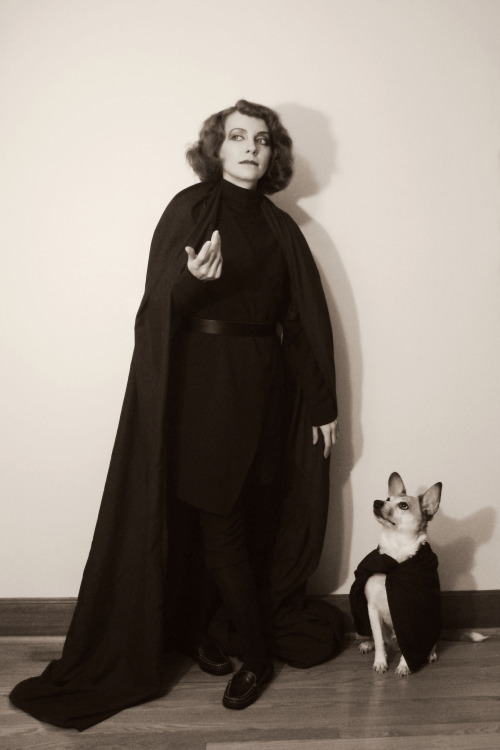
Notes
katseallday liked this
wintorphic liked this
 kinsey3furry300 reblogged this from nazguldivorce
kinsey3furry300 reblogged this from nazguldivorce nazguldivorce reblogged this from thornshadowwolf
 sublimeroadwombatnickel liked this
sublimeroadwombatnickel liked this spiky-berry21 liked this
empty-account liked this
kimocus liked this
sodaisgayplastic liked this
 delirpa liked this
delirpa liked this theimpossiblescheme reblogged this from spacesweepers
fizzwizzpop liked this
born-to-lose liked this
dancainmanpain liked this
thegentlemanstar liked this
buddingartperson liked this
 legendofthefireemblem liked this
legendofthefireemblem liked this  dogearedfriends liked this
dogearedfriends liked this grumpyfaceurn liked this
actualbiplane liked this
wherehipposdrome reblogged this from pilferingapples
mossknit reblogged this from pilferingapples
kingedmundsroyalmurder liked this
plrle liked this
sixty-silver-wishes liked this
jugularimugi liked this
maggots-in-the-drain liked this
burdenofgravity liked this
 theyeargame reblogged this from pilferingapples
theyeargame reblogged this from pilferingapples pilferingapples reblogged this from spacesweepers
 maristofeli liked this
maristofeli liked this diueliz liked this
m-siecle liked this
knifebucket liked this
 desperadore liked this
desperadore liked this spacesweepers reblogged this from amarantae
amarantae reblogged this from out-there-on-the-maroon
 nevermindhim liked this
nevermindhim liked this cherristockings liked this
mthrfckng-m1r4cl3s liked this
gautierprotectionsquad reblogged this from lackadaisycats
 salinesoils liked this
salinesoils liked this  shinladyanarki reblogged this from lackadaisycats
shinladyanarki reblogged this from lackadaisycats  ki48 liked this
ki48 liked this  margot-amapola-flores liked this
margot-amapola-flores liked this  fibula-rasa posted this
fibula-rasa posted this - Show more notes